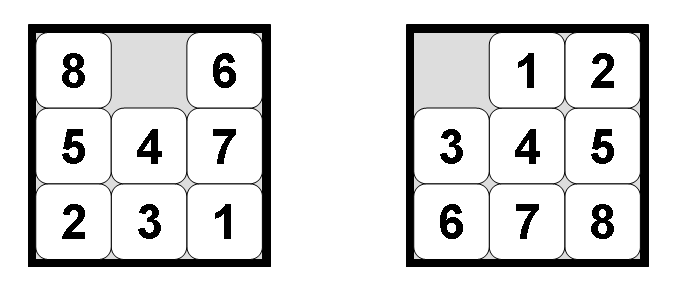8-Puzzle Problem
The 8-puzzle is a sliding puzzle consisting of eight tiles, numbered 1 through 8, placed in a 3x3 grid with one empty space. The goal is to rearrange the tiles from a given initial configuration to a goal configuration by sliding tiles into the empty space.

PuzzleState Class
The PuzzleState class represents a state of the puzzle, including the puzzle configuration, the heuristic value, and a reference to the parent state.
class PuzzleState:
def __init__(self, puzzle, heuristic, parent=None):
self.puzzle = puzzle
self.heuristic = heuristic
self.parent = parent
def __lt__(self, other):
return self.heuristic < other.heuristic
PriorityQueue Class
The PriorityQueue class is a simple implementation of a priority queue using a list. It supports operations like putting an item into the queue, getting the item with the highest priority, and checking if the queue is empty.
class PriorityQueue:
def __init__(self):
self.queue = []
def put(self, item):
self.queue.append(item)
self.queue.sort()
def get(self):
return self.queue.pop(0)
def empty(self):
return len(self.queue) == 0
Best-First Search Algorithm
The BestFirstSearch function performs the best-first search algorithm to find the optimal solution. It starts from the initial state and explores the state space by prioritizing states with lower heuristic values.
def BestFirstSearch(initial_state):
pq = PriorityQueue()
pq.put(initial_state)
while not pq.empty():
current_state = pq.get()
if IsGoalState(current_state.puzzle):
return Solution(current_state)
successors = generate_successors(current_state)
for successor in successors:
pq.put(successor)
return "No solution found"
graph TD;
A[Start] --> B{Priority Queue is not empty?};
B -- Yes --> C[Get current state from Priority Queue];
C --> D{Is current state the goal state?};
D -- Yes --> E[Construct solution path];
E --> F[Return solution path];
D -- No --> G[Generate successors for current state];
G --> H{Successors generated?};
H -- Yes --> I[Add successors to Priority Queue];
H -- No --> B;
I --> B;
B -- No --> J[No solution found];
J --> K(("No solution found"));
Heuristic Function
The heuristic function calculates the number of misplaced tiles in the puzzle configuration compared to the goal state. It is used to estimate the distance from the current state to the goal state.
def heuristic(state):
count_misplaced_tiles = 0
goal_state = [[1, 2, 3], [4, 5, 6], [7, 8, 0]]
for i in range(3):
for j in range(3):
if state[i][j] != goal_state[i][j]:
count_misplaced_tiles += 1
return count_misplaced_tiles
Other Helper Functions
- generate_successors: Generates successor states by moving the empty tile in all possible directions.
- FindEmptyPosition: Finds the position of the empty tile in the puzzle configuration.
- IsGoalState: Checks if the current puzzle configuration is the goal state.
- Solution: Constructs the solution path by tracing back from the goal state to the initial state.
def generate_successors(state):
successors = []
EmptyPosition = FindEmptyPosition(state.puzzle)
for move in [(0, -1), (0, 1), (-1, 0), (1, 0)]:
TempX = EmptyPosition[0] + move[0]
TempY = EmptyPosition[1] + move[1]
if 0 <= TempX < 3 and 0 <= TempY < 3:
Temp = [row[:] for row in state.puzzle]
Temp[EmptyPosition[0]][EmptyPosition[1]] = Temp[TempX][TempY]
Temp[TempX][TempY] = 0
successors.append(PuzzleState(Temp, heuristic(Temp), parent=state))
return successors
def FindEmptyPosition(puzzle):
for i in range(3):
for j in range(3):
if puzzle[i][j] == 0:
return (i, j)
def IsGoalState(puzzle):
goal_state = [[1, 2, 3], [4, 5, 6], [7, 8, 0]]
return puzzle == goal_state
def Solution(goal_state):
path = []
current_state = goal_state
while current_state.parent:
path.insert(0, current_state.puzzle)
current_state = current_state.parent
path.insert(0, current_state.puzzle)
return path
Test
initial_state = PuzzleState([[1, 2, 3], [4, 5, 6], [0, 7, 8]], heuristic([[1, 2, 3], [4, 5, 6], [0, 7, 8]]))
solution = BestFirstSearch(initial_state)
for soln in solution:
for sol in soln:
print(sol)
print()
Here is the entire code for you to try
class PuzzleState:
def __init__(self, puzzle, heuristic, parent=None):
self.puzzle = puzzle
self.heuristic = heuristic
self.parent = parent
def __lt__(self, other):
return self.heuristic < other.heuristic
class PriorityQueue:
def __init__(self):
self.queue = []
def put(self, item):
self.queue.append(item)
self.queue.sort()
def get(self):
return self.queue.pop(0)
def empty(self):
return len(self.queue) == 0
def BestFirstSearch(initial_state):
pq = PriorityQueue()
pq.put(initial_state)
while not pq.empty():
current_state = pq.get()
if IsGoalState(current_state.puzzle):
return Solution(current_state)
successors = generate_successors(current_state)
for successor in successors:
pq.put(successor)
return "No solution found"
def heuristic(state):
count_misplaced_tiles = 0
goal_state = [[1, 2, 3], [4, 5, 6], [7, 8, 0]]
for i in range(3):
for j in range(3):
if state[i][j] != goal_state[i][j]:
count_misplaced_tiles += 1
return count_misplaced_tiles
def generate_successors(state):
successors = []
EmptyPosition = FindEmptyPosition(state.puzzle)
for move in [(0, -1), (0, 1), (-1, 0), (1, 0)]:
TempX = EmptyPosition[0] + move[0]
TempY = EmptyPosition[1] + move[1]
if 0 <= TempX < 3 and 0 <= TempY < 3:
Temp = [row[:] for row in state.puzzle]
Temp[EmptyPosition[0]][EmptyPosition[1]] = Temp[TempX][TempY]
Temp[TempX][TempY] = 0
successors.append(PuzzleState(Temp, heuristic(Temp), parent=state))
return successors
def FindEmptyPosition(puzzle):
for i in range(3):
for j in range(3):
if puzzle[i][j] == 0:
return (i, j)
def IsGoalState(puzzle):
goal_state = [[1, 2, 3], [4, 5, 6], [7, 8, 0]]
return puzzle == goal_state
def Solution(goal_state):
path = []
current_state = goal_state
while current_state.parent:
path.insert(0, current_state.puzzle)
current_state = current_state.parent
path.insert(0, current_state.puzzle)
return path
initial_state = PuzzleState([[1, 2, 3], [4, 5, 6], [0, 7, 8]], heuristic([[1, 2, 3], [4, 5, 6], [0, 7, 8]]))
solution = BestFirstSearch(initial_state)
for soln in solution:
for sol in soln:
print(sol)
print()
Output:
[1, 2, 3]
[4, 5, 6]
[0, 7, 8]
[1, 2, 3]
[4, 5, 6]
[7, 0, 8]
[1, 2, 3]
[4, 5, 6]
[7, 8, 0]